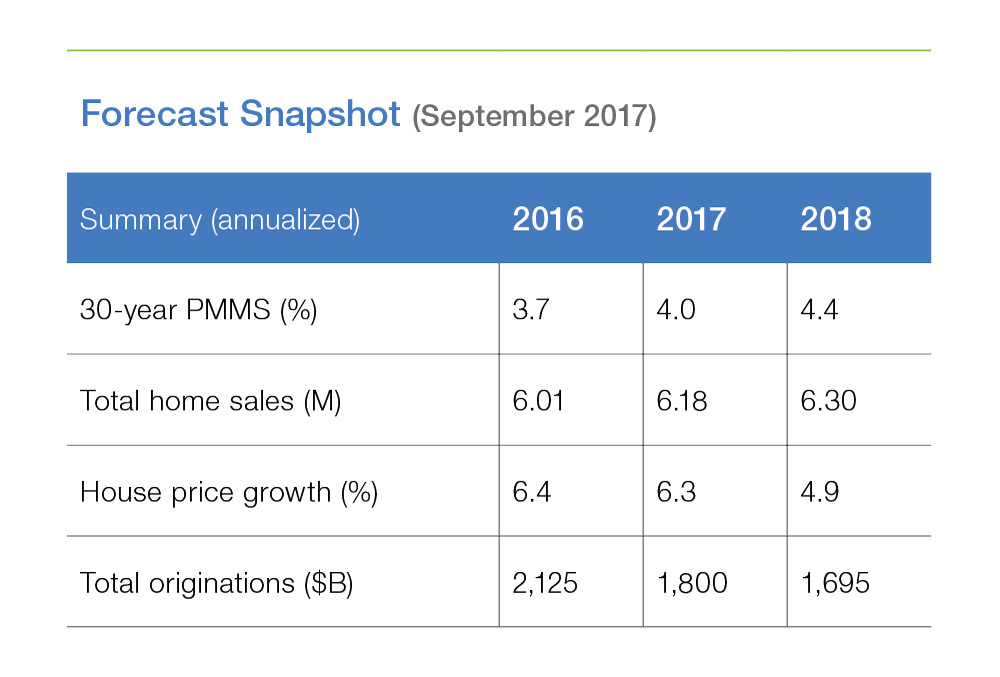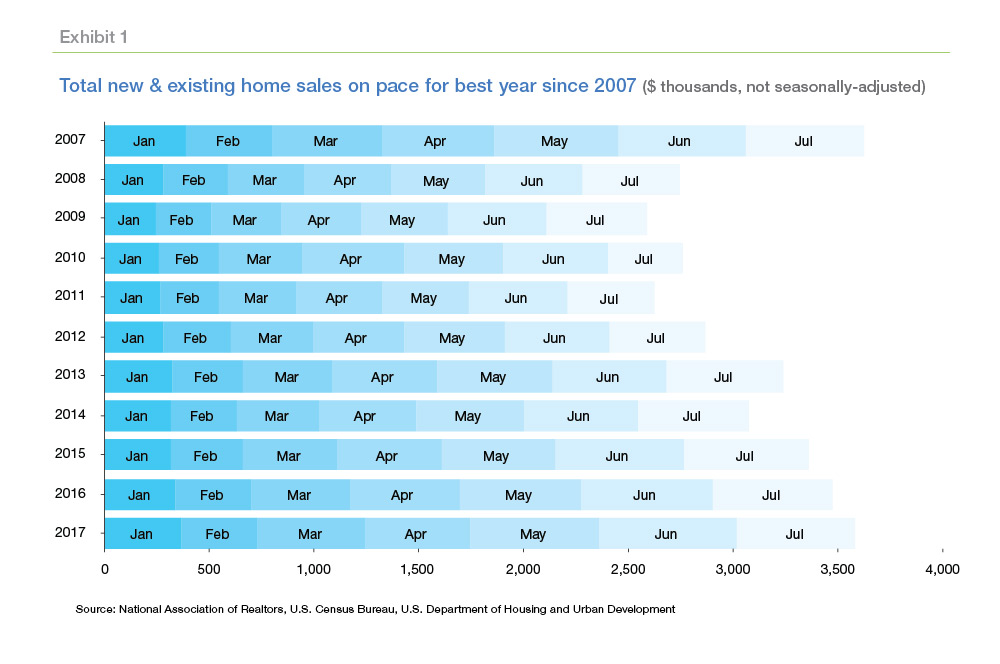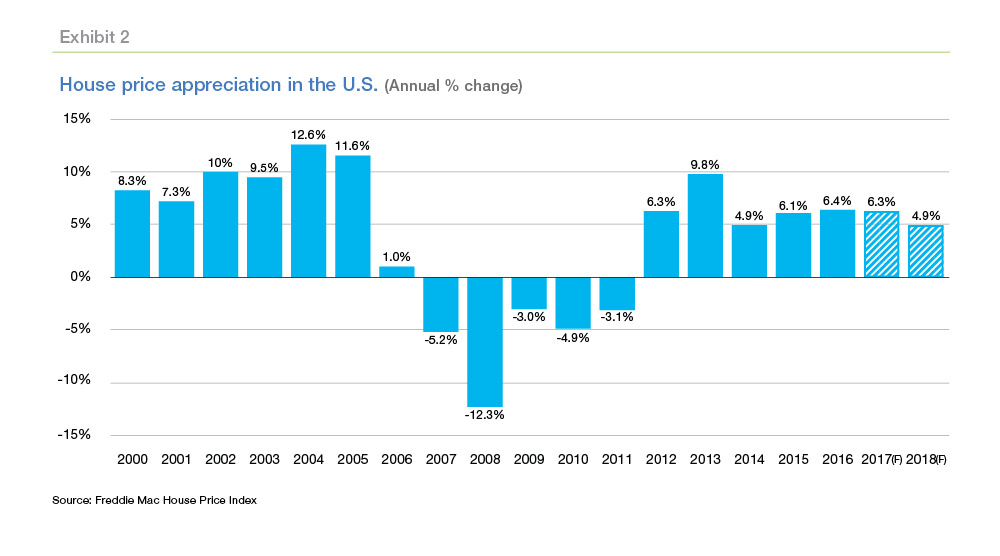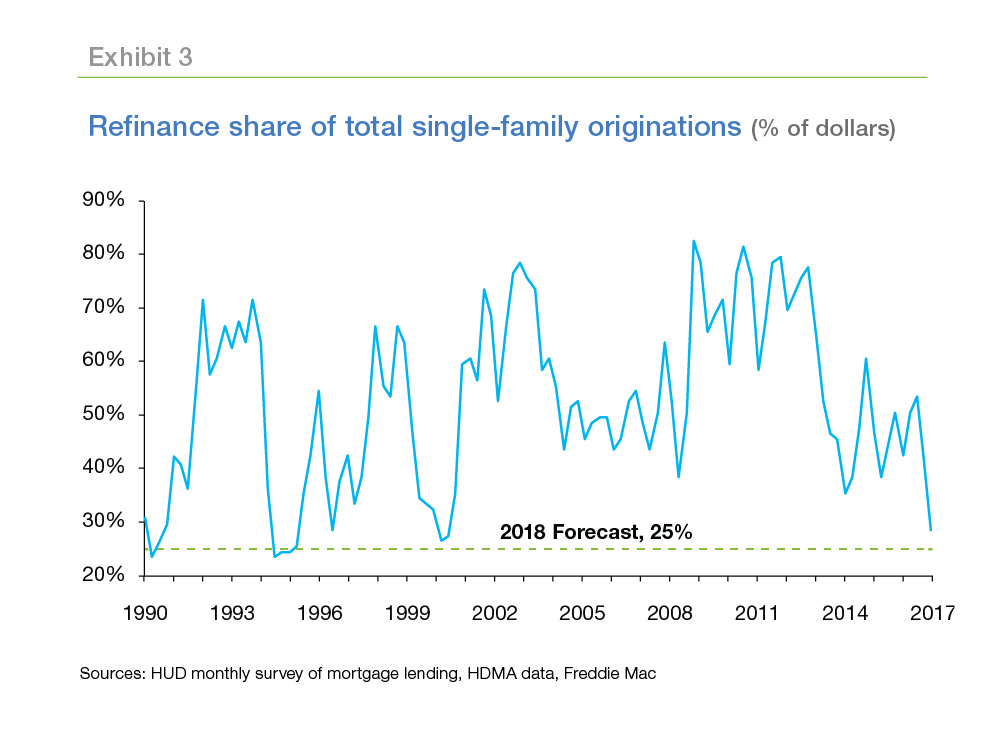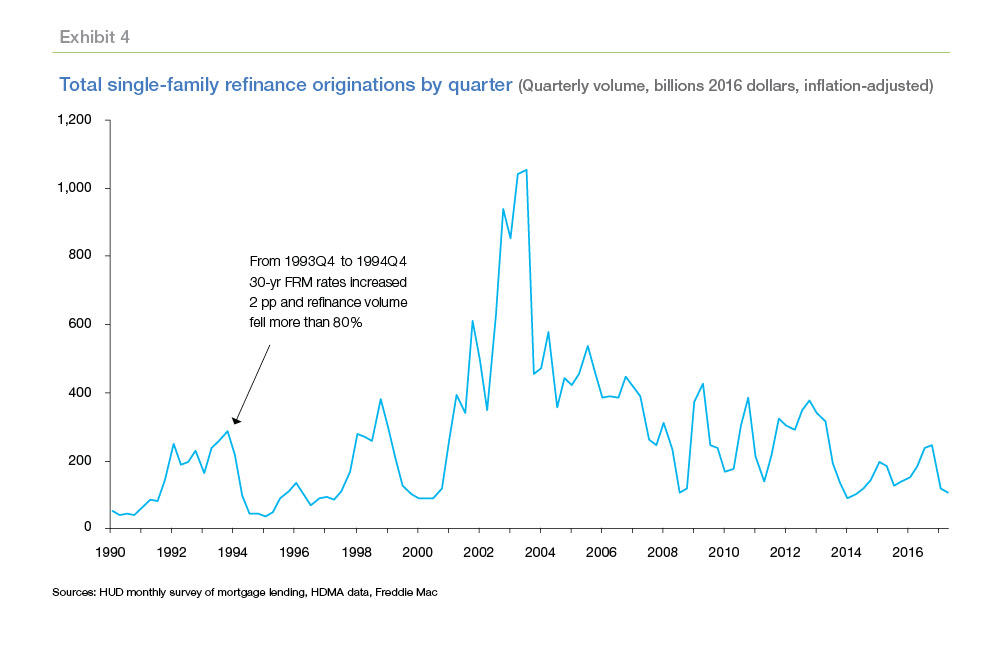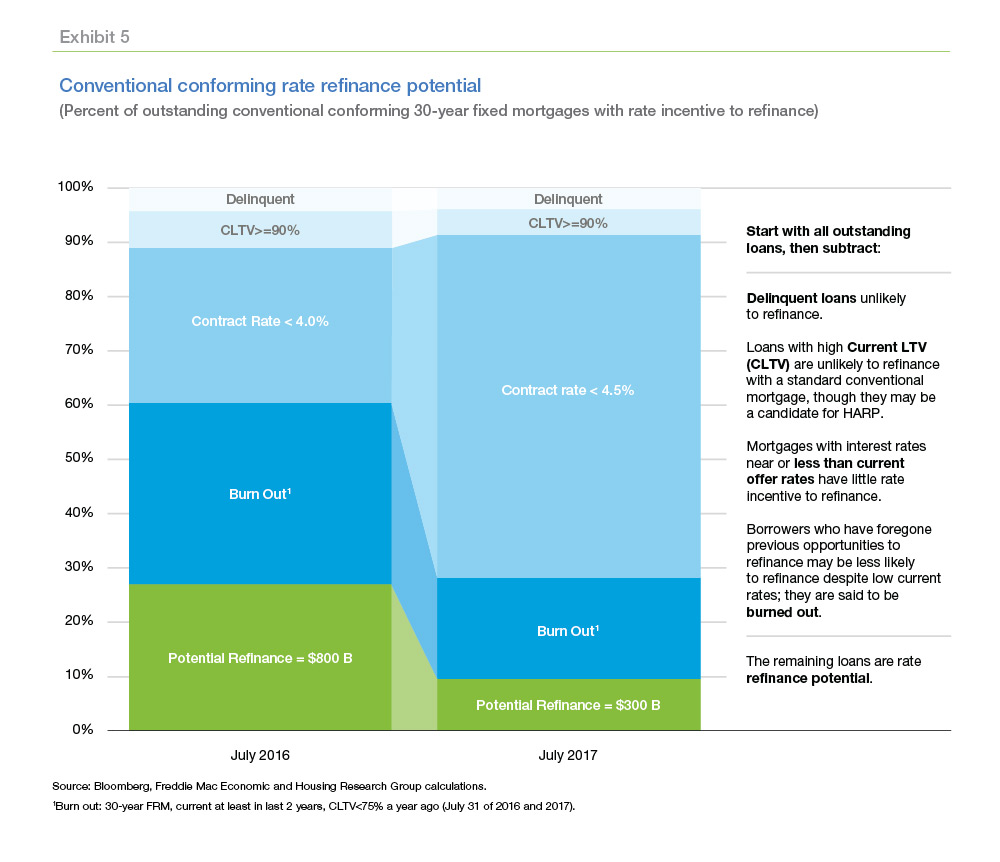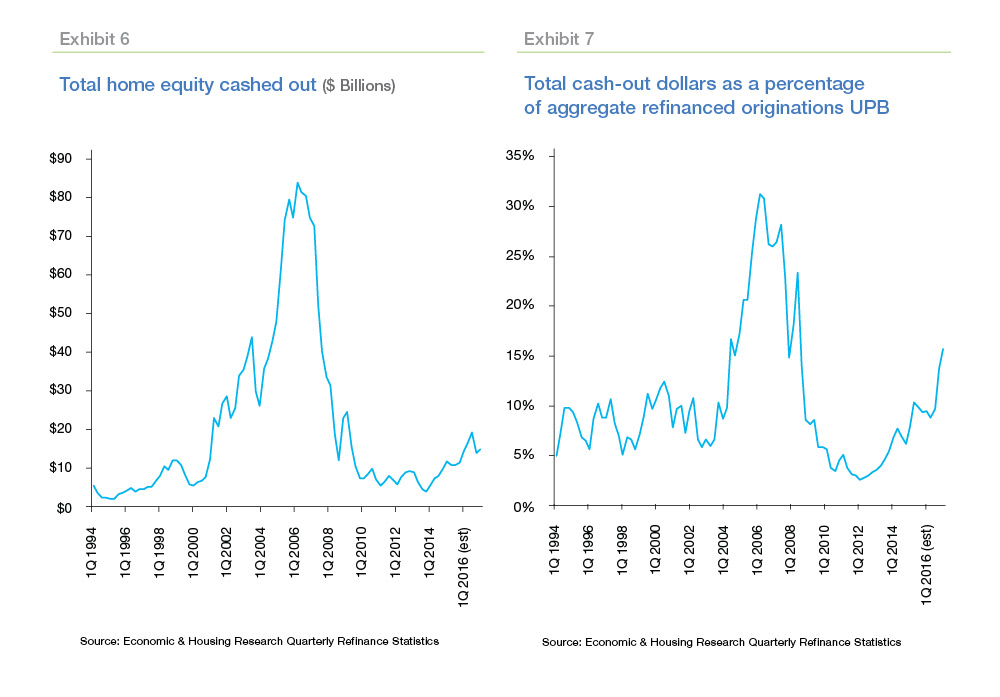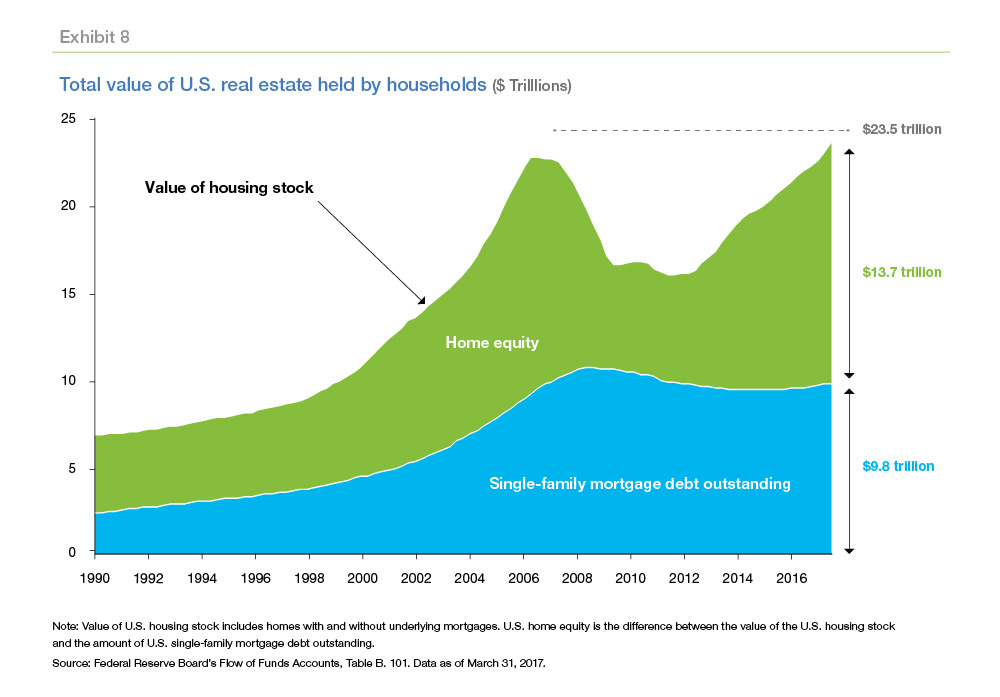Looking Ahead to 2018
The economic environment remains favorable for housing and mortgage markets. For several years, we have had moderate economic growth of about two percent a year, solid job gains and low mortgage interest rates. We forecast those conditions to persist into next year.
If the economic environment remains similar next year, what should we expect for the mortgage market?
We expect three trends to drive the mortgage market of 2018:
- Purchase mortgage volume increases
- Rate refinance activity cools
- Borrowers tap home equity
Purchase mortgage volume increases
Modest increases in home sales and house price growth should drive purchase origination volume higher next year.
Year-to-date total home sales are the highest since 2007. Existing home sales are unlikely to increase much going forward. Limited inventory will remain a persistent problem, and longer term trends like the aging of the population and declining mobility across all age groups will keep a lid on existing home sales growth. Growth in home sales will be primarily driven by new homes sales, which should continue to grind higher with single-family construction. We forecast total home sales (the sum of new and existing home sales) to increase about two percent from 2017 to 2018.
Given limited supply and robust demand, home price appreciation has been quite strong. The most recent report on the FHFA house price index indicates that house prices rose 6.6 percent from the second quarter of 2016 to the second quarter of 2017. Indeed, in many markets house price growth has topped 10 percent on a year-over-year basis, reaching over 15 percent in the Seattle metro area. A gradual increase in housing starts and moderate increases in mortgage rates will help to reduce house price growth next year. We forecast average U.S. house price growth of 4.9 percent in 2018 (Exhibit 2).
Refinance Mortgage Activity
We have seen the mortgage market shift away from a refinance-dominated market to a more purchase-oriented market. That trend will likely continue in 2018. We forecast that the refinance share of mortgage activity will decline to 25 percent, the lowest annual refinance share since 1990 (Exhibit 3). What will be the sources of mortgage refinance activity in 2018?
Rate refinance activity cools
In recent years, many homeowners have taken advantage of low mortgage rates by refinancing their existing mortgage into a new mortgage with a lower rate. With mortgage rates up from last summer's near-record lows, the potential for rate refinances has diminished.
One concern of many in the mortgage industry is: how low could mortgage refinance volume fall? If rates spike, we could see extremely low levels of refinance activity. For example, from the fourth quarter of 1993 to the fourth quarter of 1994, mortgage interest rates on the 30-year fixed rate mortgage increased about 2 percentage points. In response, refinance activity fell over 80 percent to an inflation-adjusted $40 billion in the fourth quarter of 1994 (Exhibit 4). If rates spiked by a similar amount, we could very well see similar declines.
But even if rates don't spike and remain relatively flat, refinance volumes will likely decline. How much? Last year, we estimated the rate refinance potential for the conventional market. Exhibit 5 shows an updated analysis comparing July of 2016 to July of 2017.
In July of 2016, when 30-year fixed mortgage rates averaged 3.44 percent the 30-year fixed rate conventional conforming rate refinance potential was about $800 billion. Fast forward 12 months and refinance potential has been reduced dramatically. Per Exhibit 6, conventional conforming 30-year fixed mortgage rate refinance potential as of July 2017 was down about 2/3 from the previous year to around $300 billion. Even if rates remain flat 30-year conventional rate refinance potential next year will be the lowest it has been in years.
However, refinance originations have not fallen as much as our estimate of rate refinance potential. We estimate total refinance originations for the first half of 2017 are down only about 48 percent from the first half of 2016 (as opposed to 63 percent in Exhibit 5). Our table only covers a part of the mortgage market and there are other sources of refinance to help fill in the gap left by conventional rate refinances.
Some borrowers refinance to shorten their loan term. Freddie Mac's second quarter 2017 Quarterly Refinance Statistics show that the share of refinance borrowers that shortened their loan term was 35 percent during the quarter and has been over 30 percent since the first quarter of 2013. Even if rates are up from last year, they are very low by historical standards and many borrowers choose a shorter term so they can pay down their principal faster.
Another source of additional refinance volume is borrowers refinancing out of FHA loans and into conventional loans. Earlier this year, CoreLogic estimated that as many as 250,000 borrowers might refinance out of an FHA loan into a conventional loan. Finally, some borrowers may opt to tap their home equity and take a cash-out refinance.
Borrowers tap home equity
For existing homeowners, rising home prices help increase their home equity. Homeowners looking for home improvement, to consolidate other debt or pay off student debt can cash-out home equity to do so. Under a cash-out refinance, homeowners refinance an existing mortgage into a new one with a higher principal balance to get cash in hand. Alternatively, borrowers could take out a second lien, typically through a Home Equity Line of Credit (HELOC).
In our Quarterly Refinance Statistics, we track conventional prime cash-out refinance activity. In the second quarter of 2017 the dollar volume of equity cashed out was $15 billion, up $1.2 billion from the first quarter, but down from $19.1 billion in the fourth quarter of 2016 (Exhibit 6). As rate refinance volumes wane, the share of refinances that involve cash-out has increased (Exhibit 7).
Cash-out activity, both as a share of total refinance activity and in dollars is well below levels reached last decade. Homeowner equity has increased to $13.7 trillion in the first quarter of 2017 (Exhibit 8). As home prices keep rising, cash-out activity is likely to also rise.
If mortgage rates rise or remain flat, cash-out refinance activity will become an increasingly large share of total refinance activity. Our equity extraction estimates in Exhibit 8 are only the portion of refinances that are cashed-out. Typical cash-out refinances result in a loan amount around 3 to 5 times as large as equity cashed out. If cash-out equity extraction averages $20 billion a quarter, cash-out refinance activity would contribute about $300 billion worth of refinances each year. But even if the share of cash-out refinance activity increases dramatically ($300 billion would be about 75 percent of total refinance activity), the level of overall cash-out activity will likely remain well below the levels we saw last decade and mortgage debt growth will remain modest by historical standards.
PREPARED BY THE ECONOMIC & HOUSING RESEARCH GROUP






